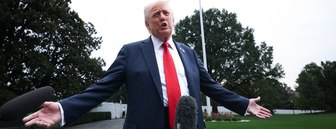Political conflict between Republicans and Democrats escalated in the 1990s, when the GOP Speaker, Newt Gingrich, made it very clear that there would be conflict between the Republican majority in the House of Representatives and Democratic President Bill Clinton. Evaluations of presidents by voters diverged politically, as demonstrated by how Americans treated the two Bush presidents: one who served before Clinton and Gingrich's speakership, and one who followed them.
In June 1992, only 34% of Americans approved of President George H.W. Bush, according to a CBS News/New York Times Poll. At that time, Bush was managing a recession, high unemployment, and a savings and loan crisis; he went on to lose the election to Clinton. There was a difference of 37 percentage points in Democrats' and Republicans' evaluations of Bush, according to the poll: 18% of Democrats approved of how Bush was handling his job, compared with 55% of Republicans.
Twelve years later, his son President George W. Bush had the approval of the same share of Americans (34%), a CBS News/New York Times Poll found. But this time the partisan gap was even greater: 6% of Democrats approved of the way Bush was handling his job, compared with 74% of Republicans — a spread of 68 points.
Since then, a wide partisan gap in presidential approval has become the norm. In Economist/YouGov Polls conducted since 2009, the partisan differences in aggregated approval ratings for Presidents Barack Obama, Donald Trump, and Joe Biden have been 71, 74, and 71 points, respectively.
Today, we expect to find differences between Democrats and Republicans on presidents' handling of issues — including health care policies, government spending, taxes, and wars. But the partisan gap also affects others who are close to recent presidents, even people with roles previously thought of as nonpolitical. An April Economist/YouGov poll found that First Ladies — the current one and others from the recent past — now generate similar polarization as do presidents. The gap in favorable opinion of Jill Biden between Republicans and Democrats was 70 points: 76% among Democrats and 6% of Republicans. More than three years after she left the White House, Melania Trump had a 76-point gap: 86% of Republicans but only 10% of Democrats held a favorable opinion of her.
Before Obama's presidency, First Ladies often floated above the partisan evaluations of their presidential husbands. During the George W. Bush Administration, that was true. In mid-2006, while President Bush’s favorability rating was declining, his wife’s rating remained high.
In June 2006, a 58% majority of Democrats had a favorable opinion of Laura Bush and there was just a 34-point difference between Republicans and Democrats, according to a Gallup/USA Today Poll — half the partisan gap in opinion about her husband, President Bush. The partisan gap was wider for Hillary Clinton and Michelle Obama while they were First Ladies. Both were more active politically than many earlier First Ladies. But even their partisan gaps were narrower than Jill Biden’s now.
Images of the opposing party were always negative. Voting behavior is heavily partisan, as more than 90% of Democrats and of Republicans typically vote for their own party’s candidates. But now, the share of people who identify with each party viewing the other party favorably is barely above 10% in aggregated Economist/YouGov Polls conducted during the Biden Administration. Favorable evaluations of the opposing party in Congress are even rarer, below 10% in recent polls.
Perhaps the most notable example of polarization is how Democrats and Republicans view the people who identify with the other party. Even seeting aside their political differences with Republicans, less than half of Democrats say the two groups still share many other values and goals. And the same goes for Republicans' views of Democrats.
In March 2007, when George W. Bush was in office, more than four in 10 Democrats (46%) and more than four in 10 Republicans (43%) said that despite their political differences with people who identified with the opposite party, they still shared many other values and goals with people in the opposite party, according to the CBS News/New York Times Poll. However, at least half of each party’s identifiers — 51% of Democrats and 53% of Republicans — said they did not. An even higher share of Republican conservatives felt Democratic Party identifiers shared few values with them.
In the 17 years since then, the gap has only widened, with Republicans becoming more skeptical than Democrats. An Economist/YouGov Poll conducted in late April asked a question similar to the 2007 poll and found that about one-third of Democrats now believe Republicans share their nonpolitical values, and only one-quarter of Republicans say the same about Democrats. Fewer than one in five Republicans who identify as MAGA say that. Liberal Democrats and conservative Republicans are more negative about the opposing party than moderates in either party.
When disagreements aren’t just about policy, and Americans who identify as Democrats or Republicans think they have little in common with people on the other side politically, we're left with today’s heavily polarized political world.
— Paul Teas, Carl Bialik, and Taylor Orth contributed to this article
Methodology for Economist/YouGov Poll: Respondents were selected from YouGov’s opt-in panel using sample matching. A random sample (stratified by gender, age, race, education, geographic region, and voter registration) was selected from the 2019 American Community Survey. The sample was weighted according to gender, age, race, education, 2020 election turnout and presidential vote, baseline party identification, and current voter registration status. Demographic weighting targets come from the 2019 American Community Survey. Baseline party identification is the respondent’s most recent answer given prior to a certain date, and is weighted to the estimated distribution at that time. The margin of error for the overall sample on a single poll typically is approximately 3%.
Image: Getty













